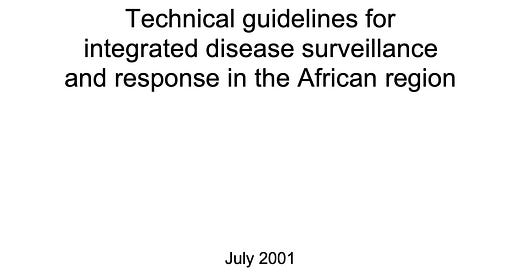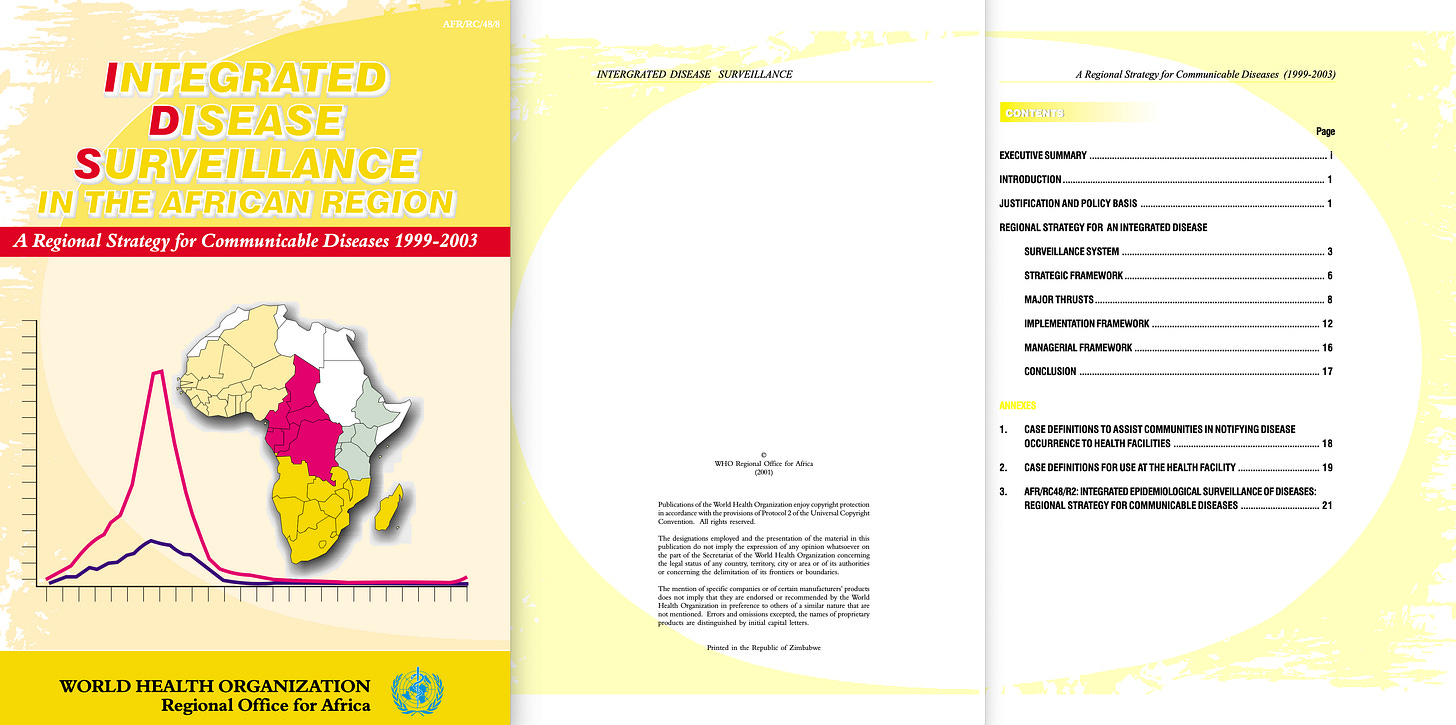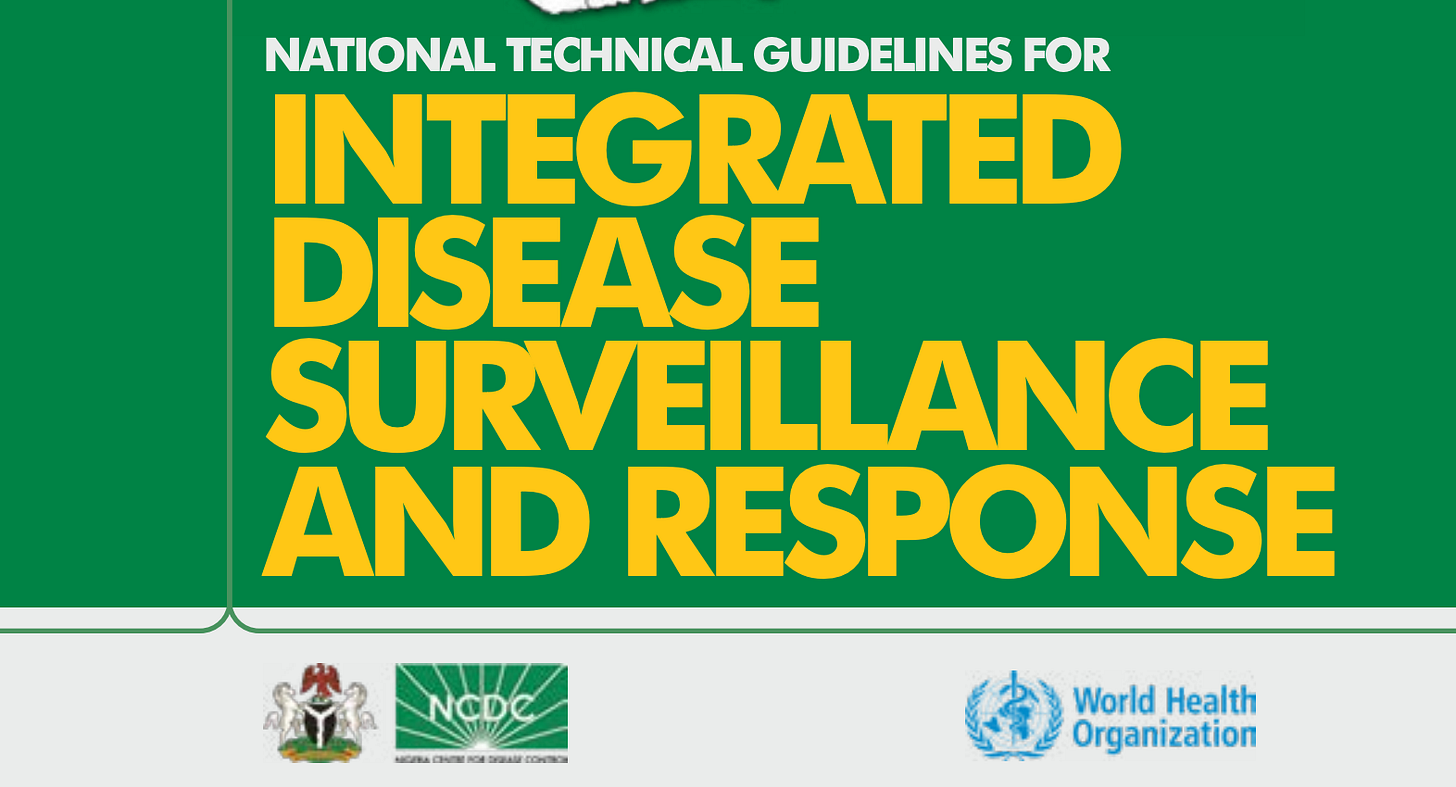Integrated Disease Surveillance and Response
In July 2001, the World Health Organisation released a document titled ‘Technical guidelines for integrated disease surveillance and response in the African region‘.
And what that document clears right up, is that the global surveillance strategy has been decades in the making.
-
I’m going to do something unusual. I’m going to bail out of the document almost immediately, because the primary part of interest can be located in the introduction - resolution AFRO/RC48/R2.
Briefly stated, the resolution approves a strategy, focusing on integrated surveillance for the sake of disease monitoring.
It calls for an exhaustive evaluation of disease surveillance systems, and laboratory components of each African member state, and for each member to upgrade surveillance and laboratories as required, and for the member states to participate in a regional cooperation, which will enable rapid notification of epidemics to the WHO and neighbouring nations.
It’s a script we’ve seen before. But generally, rather a lot later, as this was penned in September, 1998.
The document goes on to reference another, more detailed - and eye opening - document, which can be located here. The original document was supposedly released in 1999, though this one states 2001. I have no reason to doubt its authenticity, I have sourced this version as I seriously struggle to access WHO documents.
The title of the document is ‘Integrated Disease Surveillance in the African Region - A Regional Strategy for Communicable Diseases 1999-2003’.
And it’s utilising what must be the worst colour scheme ever witnessed in a public document. Bright yellow on white? I mean, why not use Comic Sans while at it?
It starts off by chronologically listing all the various, progressive resolutions, which culminated in RC48/R2 - all based on surveillance, and detailing progressive inclusion of various data and initiatives -
WHA22.47 (1969)
WHO requests member states to perform epidemiological surveillanceWHA41.28 (1988)
WHO requests intensified surveillance, and timely reporting of cases at national and international levels.AFR/RC38/R9 (1988)
HIV/AIDS surveillance called for by the African regional office of the WHO.AFR/RC38/R34 (1988)
Collaboration with fellow member states called for by WHO Africa.AFR/RC38/R13 (1988)
WHO Africa calls for intensified surveillance of dracunculiasis, and regular reporting thereof to the WHO.AFR/RC43/R7 (1993)
WHO Africa calls for strengthened epidemiological surveillance.WHA48.13 (1995)
WHO calls for active surveillance for infectious diseases, and coordination between member groups.
The evaluation of the various surveillance systems revealed duplications of efforts, and further, that the collection, analysis, utilisation, and dissemination of the surveillance data had been inadequate, that too little attention was paid to integrating the surveillance systems, that these systems didn’t include pneumonia and malaria, and that the laboratories were inadequate and poorly integrated.
To rectify this, they came up with a plan -
All surveillance activities should be integrated.
All work to implement said integration, should be coordinated by a surveillance unit, which also is put in charge of data management.
Priority diseases should be listed for inclusion.
Case definitions should be introduced, for selected diseases.
And a long-term goal is added; ‘data collection for action’, where said data is communicated up the hierarchy in a continuous and ‘timely’ manner.
I bet you read this book before.
Amusingly, it is requested that this system is ‘flexible’ (allowing for more diseases, more data, and no doubt a change in reporting time intervals), that the data should be made available to ‘specific intervention programmes’, and that it should be ‘reliable’ and ‘complete’, which basically mean that all data requested should be sent up the hierarchy, within the period of time requested.
Ultimately, by 2003, the plan was for the entire system to be rolled out, member states should have formed central coordinating bodies, established national integrated surveillance systems, utilising a reinforced laboratory network.
The document goes on to further request surveillance data on antimicrobial resistance (AMR), supposedly because of malaria, tuberculosis and pneumonia. Though only a limited quantity of data should be sent up the hierarchical chain, ‘health facilities are expected to record all necessary information on each individual case for future use’, in effect meaning that all your data will eventually be forwarded. It’s just a matter of time before the ‘correct’ excuse has been devised.
Reporting interval of diseases varies by type - routine reports, for instance, should be forwarded only once per month, but epidemic reporting and case-based reports should be forwarded immediately. Yup, eventually, ‘immediately’ will be changed to ‘real-time’, after all - it’s supposed to be a ‘flexible’ approach, per the document.
Oh yeah - and all matters relating to AMR should also be forwarded… immediately, eventually arriving at the central server of the WHO… immediately. The intent here is fairly clear - the document later states that the ‘fastest means of communication… should be used’. All of this essentially outlines the globally coordinated approach they’re currently budy rolling out.
To integrate all of this, the Task Force for Emerging and Re-emerging Communicable Diseases can play an active role.
On a national level, the approach should be centralised, and potential governmental partners - like the ministry of agriculture - should likewise be integrated.
And all of this - in 1998-9. The global surveillance was being orchestrated already back then. Of course, we know it was already in the Western world by then, because ECHELON officially kicked off in 1998.
But there was a reason why I kicked this off with the above document. Because it really was very much implemented. Here’s Ghana, 2002.
Ethiopia, … 2004.
Uganda, …… 2017.
Here’s a report on Zambia…. 2017.
Here’s Nigeria. 2019. Ever so slightly behind schedule, it would appear.
In fact, a number of articles in medical journals were written on the state of national adoption and implementation - here’s one from the BMJ. Yes, the initiative, which was supposed to be fully implemented by 2003 was running somewhat behind schedule.
Remind me again, in which year did PEPFAR launch?




















